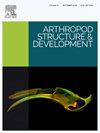Glomerular organization of the antennal lobe in the fall webworm Hyphantria cunea (Drury, 1770)
IF 1.3
3区 农林科学
Q2 ENTOMOLOGY
引用次数: 0
Abstract
The fall webworm (Hyphantria cunea), a typical destructive invasive pest, has caused substantial damage to both the ecological environment and economy in China. H. cunea uses primarily its antennae to locate food and perceive pheromones through stimulation of olfactory receptor neurons. These receptor neurons project their axons into glomeruli within the antennal lobes, the primary olfactory center in the brain. The projection patterns of sensory antennal neurons into the antennal lobe and its precise structure have not been described so far. To decipher the primary organization behind olfactory recognition in H. cunea, this study employed synaptic antibody immunostaining, as well as mass staining of olfactory sensory neurons (OSNs), and computer-based reconstruction to establish a three-dimensional olfactory glomerular map of the moth's antennal lobes. A total of 74 male and 81 female antennal lobe glomeruli were identified, including 3 male-specific glomeruli (Macroglomerular complex, MGC) and 8 female-specific glomeruli (DL1-DL8). While the Cumulus (Cu) volume was largest in MGC, the differences in volume among dorsomedial anterior and dorsomedial posterior were minimal. These findings lay the groundwork for a better understanding of the olfactory anatomical organization in H. cunea.
秋蛛触角叶的肾小球组织(Drury, 1770)
秋网虫(Hyphantria cunea)是一种典型的破坏性入侵害虫,对中国的生态环境和经济都造成了巨大的破坏。野蝇主要使用触角来定位食物,并通过刺激嗅觉受体神经元来感知信息素。这些受体神经元将轴突投射到触角叶的肾小球中,触角叶是大脑的初级嗅觉中心。感觉触角神经元在触角叶的投射模式及其精确结构至今尚未被描述。为了揭示飞蛾嗅觉识别背后的主要组织,本研究采用突触抗体免疫染色、嗅觉感觉神经元(OSNs)的团块染色和基于计算机的重建,建立了飞蛾触角叶的三维嗅觉肾小球图。共发现74个男性和81个女性触角叶肾小球,包括3个男性特异性肾小球(Macroglomerular complex, MGC)和8个女性特异性肾小球(DL1-DL8)。虽然MGC的积云(Cu)体积最大,但前背内侧肌和后背内侧肌的体积差异很小。这些发现为更好地了解美洲古猿的嗅觉解剖组织奠定了基础。
本文章由计算机程序翻译,如有差异,请以英文原文为准。
求助全文
约1分钟内获得全文
求助全文
来源期刊
CiteScore
3.50
自引率
10.00%
发文量
54
审稿时长
60 days
期刊介绍:
Arthropod Structure & Development is a Journal of Arthropod Structural Biology, Development, and Functional Morphology; it considers manuscripts that deal with micro- and neuroanatomy, development, biomechanics, organogenesis in particular under comparative and evolutionary aspects but not merely taxonomic papers. The aim of the journal is to publish papers in the areas of functional and comparative anatomy and development, with an emphasis on the role of cellular organization in organ function. The journal will also publish papers on organogenisis, embryonic and postembryonic development, and organ or tissue regeneration and repair. Manuscripts dealing with comparative and evolutionary aspects of microanatomy and development are encouraged.

 求助内容:
求助内容: 应助结果提醒方式:
应助结果提醒方式:


